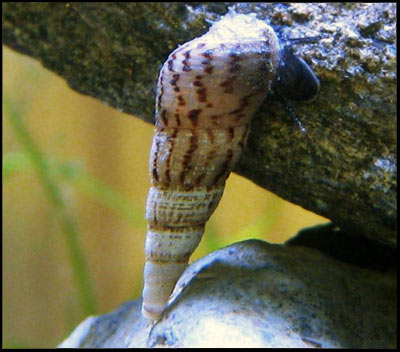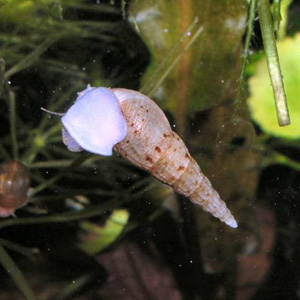Classification
Domain-Eukarya
Kingdom-Animalia
Phylum-Mollusca
Class-Gastropoda
Order-Sorbeoconcha
Family-Thiardae
Genus-Melanoides
Species-
Melanoides tuberculata
The Latin meaning of Melanoides tuberculata, could not be determined from any source that we could find, or use.
Domain-Eukaryotes: According to Keelings, the Eukaryota is one of the three super groups and is the most complex in terms of cellular complexity, and a structure. People generally think of eukaryotes as the large organisms that are interacted with each day such as plants, and large animals; but there are millions more microscopic eukaryotes that we cannot see. Most eukaryotes have similar structures amongst them such as the cytoskeleton, and system of membrane components. The word eukaryote means “true kernel”, because of the way that the genome is contained in the nucleus (Keelings, 2003).
Kingdom-Animalia:As stated by Keelings, Animalia is one of the lineages that can be traced back, and helps get a clearer understanding of the history of the earth (Keelings, 2003). All members of Animalia are multicellular, and they are heterotrophs, most of them digest this food in a internal cavity (Meyers, 2001). Most animals derive their energy from feeding on other things, such as other animals, plants, and decaying matter (Keelings, 2003).
Phylum-Mollusca: This phylum contains some of the most familiar invertebrates, which includes slugs, clams, mussels, octopuses, and snails (Keelings, 2003). The structure that most molluscs have is a well-developed, muscular foot, they use it in multiple ways such as; locomotion, clinging to surfaces, burrowing, anchoring, swimming in sediment, and grasping (Keelings, 2003). Molluscs are adapted to be both terrestrial, and freshwater and marine habitats (Keelings, 2003).
Class-Gastropodia: This class contains snails and slug, unique to the snails are the single spirally coiled shell, some snails have reduced use of the shell or have lost it entirely such as slugs. Unique characteristics to gastropods is the torsion or a rotation of the visceral mass, and the mantle of the foot, this means that the anus is above the mouth. Gastropods have developed ways to stop the waste from being absorbed in the gills, or eaten (Meyers, 2001). These gastropods are the largest group in the phylum Mollusca, they comprise 80% of all living mollucs (Meyers, 2001).
Order- Caenogastropoda: This order is one of the major clades of the class gastropoda, these gastropods are mostly aquatic, and can survive in both salt and freshwater (Taylor, 2011) .
Family-Thiardae: This family consists of freshwater snails, which are mostly lake-dwelling (Taylor, 2011).
Genus-Melanoides: This genus contains freshwater snails that have an operculum. Species-Melanoides tuberculata: Contains the Red-rimmed snail also know as red-rimmed melania, has a parasitic relationship with nematodes, and is popular in the aquarium trade. (MelanoidesTuberculata,2007)

